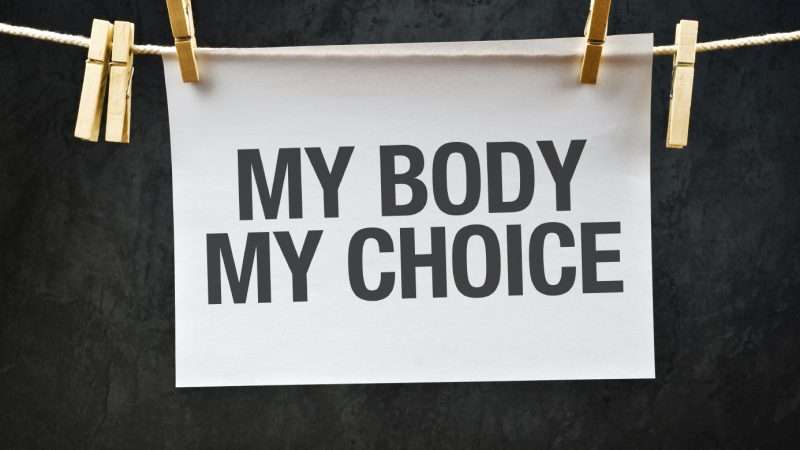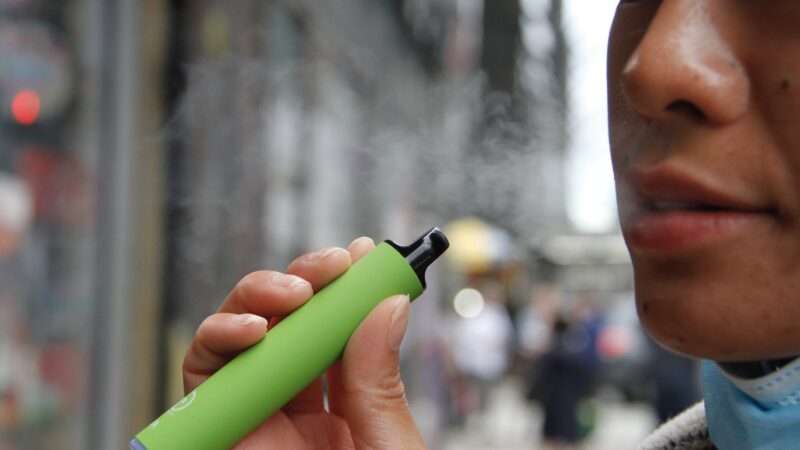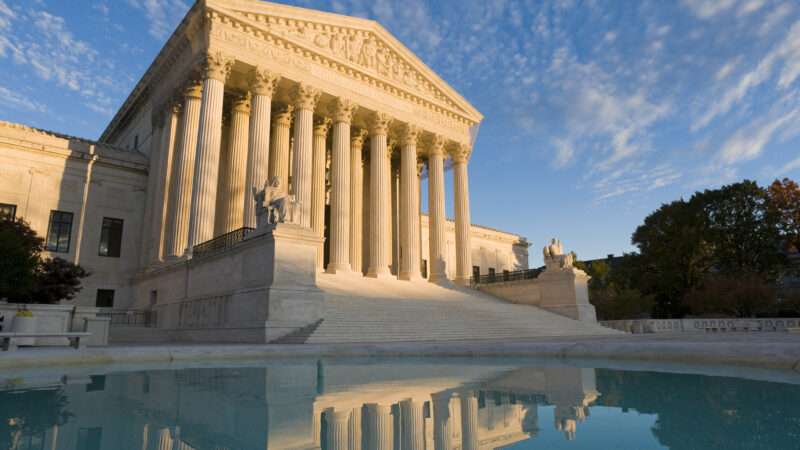

The Supreme Court’s reversal of Roe v. Wade has re-focused attention on the moral principle of “My Body, My Choice,” advanced by the pro-choice movement. I agree with both the general principle, and with almost of all of its applications to the specific case of abortion. But the idea has implications that go far beyond abortion, including many of that are easier to defend and some that could potentially save large numbers of lives. It frustrates me that many who propound the principle when it comes to abortion ignore or even oppose it in other contexts. Many on the political right are also inconsistent when it comes to issues of bodily autonomy.
In this post, I explain why abortion is a relatively hard case for the “My Body, My Choice” principle. If you believe (as I do) that it nonetheless applies here, you should be even more willing to apply it in many other cases. And some of those other applications are enormously significant.
Abortion is actually a difficult case – even for libertarians and others who generally take a broad view of bodily autonomy. Political philosopher Michael Huemer and Clark Neily and Jay Schweikert of the Cato Institute have helpful discussions of the reasons why. I won’t try to go over all of their analysis. But much of it comes down to the reality that there is a plausible case that abortion involves the taking of innocent life. And if it does, that effect happens almost every time. It’s not just a marginal probablistic risk.
To be sure, libertarians and many others argue that we don’t necessarily have a moral duty to save lives whenever we can, especially not one that should be enforced by the government. Similarly, Anglo-American law holds there is no liability if you walk by a baby drowning in a lake and choose not to save her (though some philosophers and legal scholars believe there should be). But, if a fetus has a right to life comparable to that of a baby, then abortion is a harder case than the “drowning baby” scenario. In most, though not all, cases (rape is an obvious exception) the pregnant woman had a major role in putting the fetus in a position of jeopardy in the first place, by voluntarily choosing to have unprotected sex.
This makes the situation very different from one where the drowning baby was in peril for reasons having nothing to do with the person who might save it. If you threw the baby in the water, or he ended up there through your negligence, you do indeed have a legal or moral duty to save him.
I think that “my body my choice” nonetheless justifies foregoing abortion restrictions in the vast majority of situations. Primarily, that’s because I think fetuses (except perhaps in the very late stages of pregnancy) do not have a right to life comparable to that of infants. In addition, the severity of the burden imposed on pregnant women’s bodily autonomy by abortion restrictions imposes a high burden of proof on defenders of such laws. I don’t think pro-lifers have met that burden. But the issue is a genuinely hard one, despite the tendency of many on both sides to think that it’s easy.
By contrast, a large number of other restrictions on bodily autonomy are much simpler cases, at least if you believe in a strong presumption in favor of “my body, my choice.”
I listed several examples in a 2019 post on this subject. The list below includes some additions, whose importance has been highlighted by recent events:
1. Organ markets should be legalized. People should be free to sell kidneys, for example (subject, perhaps, to informed consent requirements). If someone wants to sell a kidney, the response to prohibitionists should be: “you can’t tell her what to do with her goddamn body, ever.” Your kidney is part of your body, and the decision to sell should be your choice. As an extra bonus, legalizing such sales would save many thousands of lives.
2. Laws against prostitution should be abolished. They most definitely restrict people’s freedom to control their own bodies (both prostitutes and their customers). The prostitute’s body belongs to her, and using it for prostitution is her choice. Prostitution bans also restrict the bodily autonomy of customers. Thus, we should reject laws that punish them, while letting the prostitutes themselves go free. The “johns” own their own bodies no less than the prostitutes do. The kind of consensual sex you engage in with your body should be your choice.
3. The War on Drugs should be abolished. All of it. Not just the ban on marijuana. Its whole purpose is to restrict what sorts of substances you can put in your body. What you put in your body should be your choice. And, like the ban on organ sales, the War on Drugs harms large numbers of people, both in the US and abroad, in countries like the Phillippines and Mexico.
4. The government should not try to control people’s diets through “sin taxes,” or restrictions on the size of sodas, and other such regulations. Here too, the goal is to restrict what we put in our bodies. If that leads to increased government spending on health care, the right solution is to restrict the subsidies, not bodily autonomy.
5. Draft registration, mandatory jury service, and all other forms of mandatory service should be abolished (if already in force) or taken off the political agenda (if merely proposed). All such policies literally expropriate people’s bodies. What work you do with your body should be your choice.
6. We should legalize and use challenge trials for testing new vaccines against deadly diseases. The resulting earlier authorization of Covid-19 vaccines might have saved many thousands of lives. And it could save many more if we permit the use of challenge trials in the future.
7. Government-imposed mask mandates and lockdowns should be forbidden, or at least there must be very strong presumptions against them. Accumulating evidence suggests that lockdowns did little good, and that the benefits of mask mandates are also modest, at best, as indicated by the serious flaws in the study most often cited to support them. At the very least, true advocates of “my body, choice” should have a strong presumption against such measures, inasmuch as they are truly massive intrusions on bodily autonomy, at least if continued for more than very brief periods. If they can be justified at all, it can only be by overwhelming evidence of large, life-saving effects. Or at least that’s true if you have a strong commitment to “my body, my choice.”
8. People should be allowed to take experimental medical treatments not approved by government regulators. That’s especially true if the treatments have a significant chance of saving people from death or serious illness.
9. The Biden administration should drop its proposed ban on “vaping”. Respect for “my body, my choice” requires us to let people decide for themselves whether they want to consume such products or not.
Like my earlier 2019 list, the above is far from exhaustive. But it’s at least a rough indication of what truly consistent application of “my body, my choice” entails.
The organ market and challenge trial cases are especially worth highlighting. In both cases, eliminating limitations on bodily autonomy would not only expand freedom of choice, but also save enormous numbers of lives! This makes these situations far easier cases than abortion, where – as discussed above – there is a serious argument that freedom of choice entails the taking of innocent life. And yet organ markets and challenge trials get no more than a fraction of the attention and support that are focused on abortion rights.
Many of the items on the above list highlight inconsistencies by pro-choice liberals. But there is no shortage of similar inconsistency on the right. Consider, for example, conservatives who oppose mask and vaccine mandates on grounds of bodily autonomy, but strongly support the War on Drugs and laws banning prostitution.
Some will object that many of the cases described above must be ruled out because they involve restrictions on activities that are dangerous to health or safety (e.g. – prostitution, taking risky illegal drugs, and so on). If an activity is too dangerous, then government should be able to ban it in order to protect people from their own worst impulses.
But if that’s your view, you’re not really a supporter of “my body, my choice.” Rather, you believe people should only be allowed to make choices that the government (or perhaps some group of experts) deems sufficiently safe. Among other flaws, such paternalism overlooks the possibility that people may legitimately differ over the amount of risk they are willing to accept.
Another standard objection to some of the items on my list is the fear that allowing them would lead to “exploitation” of the poor. For example, the poor may face more pressure to sell organs, become prostitutes, participate in challenge trials (if participants in the latter are allowed to be paid). I have responded to this objection in some detail in previous writings on organ markets and challenge trials.
Here, I will add that the very same issue arises with abortion. After all, many abortions occur at least in part because the women who get them are poor and want to avoid further economic hardship. If we are going to bar poor people from taking risks with their bodies in order to alleviate difficult economic circumstances, that, too, entails massive deviation from “my body, my choice.”
Longtime readers may wonder whether the above is consistent with my willingness to support some types of vaccination mandates. The answer is that this is consistent with the framework outlined in my 2019 post on this subject (written before the Covid pandemic made this a major issue):
I do not believe any right should be absolute. A great enough harm… might justify restricting virtually any liberty, if that were the only way to prevent it. But those who take the principle of bodily autonomy seriously should at least adopt a strong presumption against restrictions, and only support them in cases where there is very strong evidence both that the harm exists and that restricting liberty will solve the problem without creating comparably serious harms of its own.
I should clarify that the “great harm” in question is harm to third parties, not to the person whose autonomy is being restricted. In the case of vaccination against deadly contagious diseases, the harm prevented is potentially very great (loss of thousands of lives) and the restriction on liberty is small. In most cases, once you get the shot you can go back to your normal life very quickly, and you no longer even notice the presence of the vaccine. That’s a sharp contrast with such cases as lockdowns, mask mandates, the War on Drugs, and – yes – abortion restrictions, which impose severe constraints on liberty over long periods of time, sometimes even indefinitely.
Obviously, the case for vaccination mandates also rests on the assumptions that 1) vaccination significantly reduces disease spread (as opposed to merely protecting the vaccinated themselves), and 2) voluntary vaccination won’t be widespread enough to make compulsion unnecessary. Thus, defensible vaccination mandates are a fairly unusual case where the combination of large potential benefits and the very modest nature of the restriction on liberty, combine to overcome even a strong presumption in favor of bodily autonomy.
This post, like its predecessor, obviously cannot do justice to all the implications of “my body, my choice,” or deal with all possible case-specific arguments for restriction. Elsewhere, I have addressed some of the latter with respect to organ sales, mandatory jury service, and mandatory national service generally, among other cases.
But I hope it at least shows that many supporters of the “my body, my choice” principle should consider broadening their horizons by applying it more consistently, to a wider range of issues. Some of those issues even involve massive, glaring injustices that so far have failed to attract more than a fraction of the attention they deserve.
The post A Broader Perspective on "My Body, My Choice" appeared first on Reason.com.
from Latest https://ift.tt/IX9QBGj
via IFTTT






